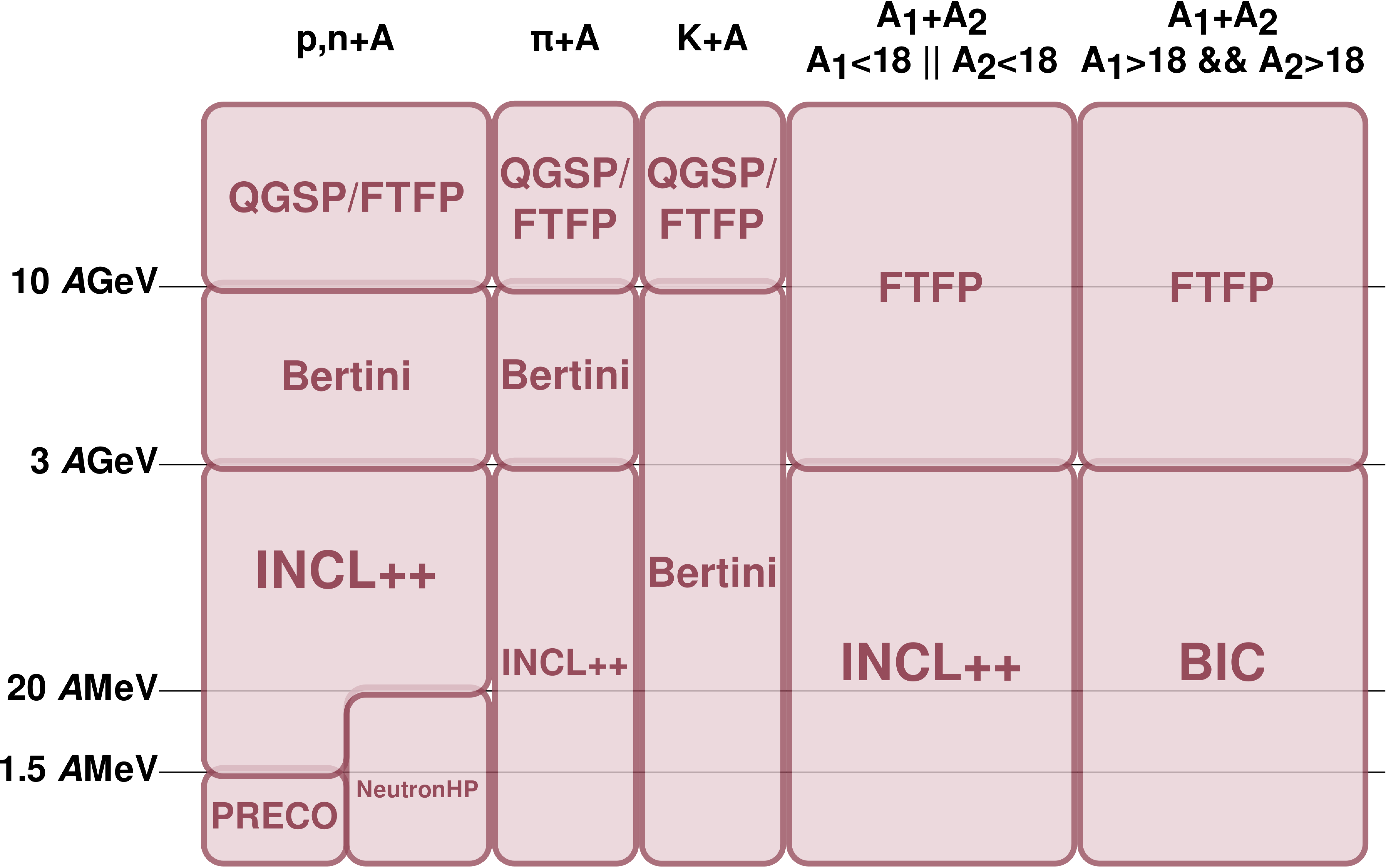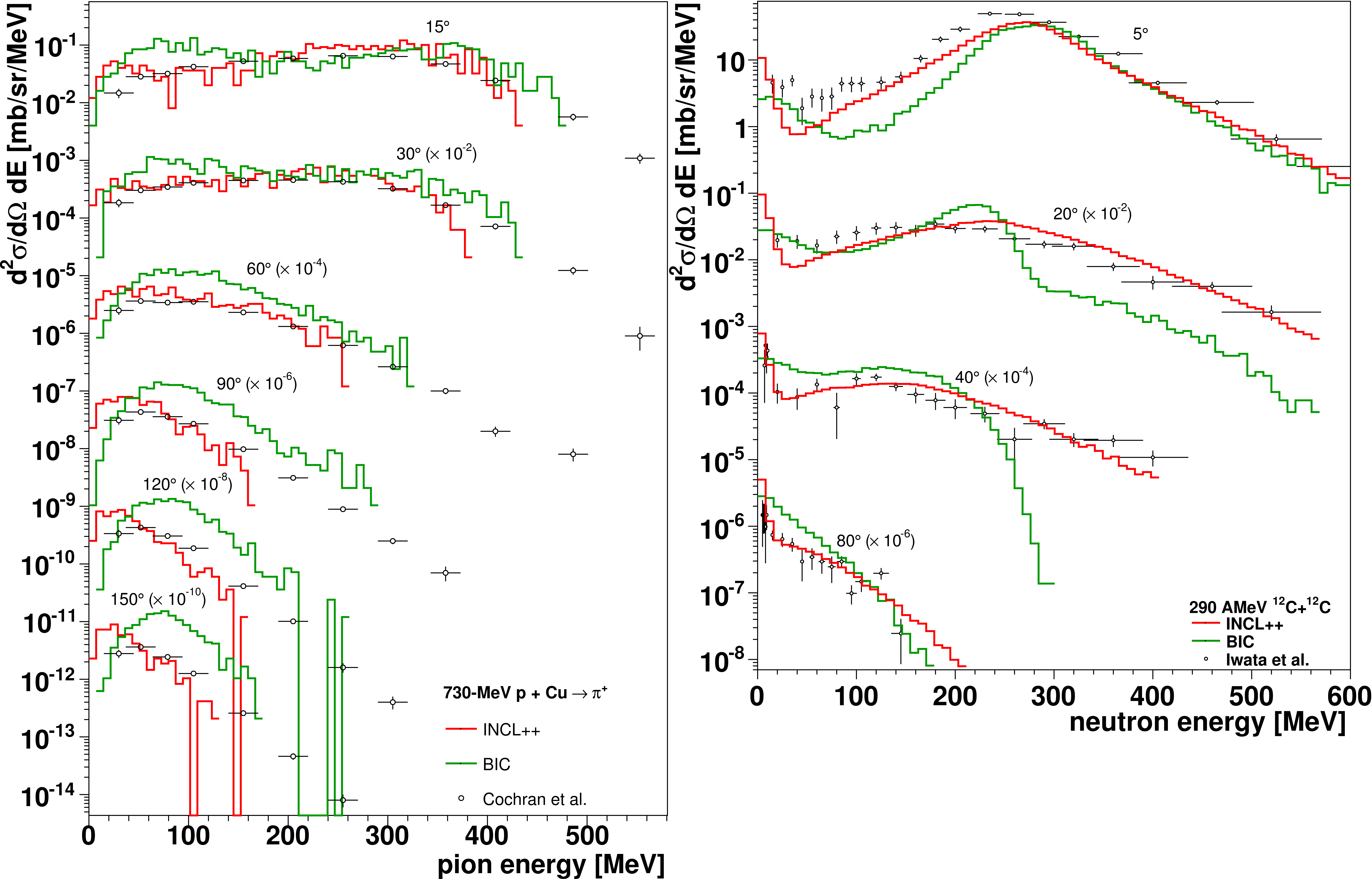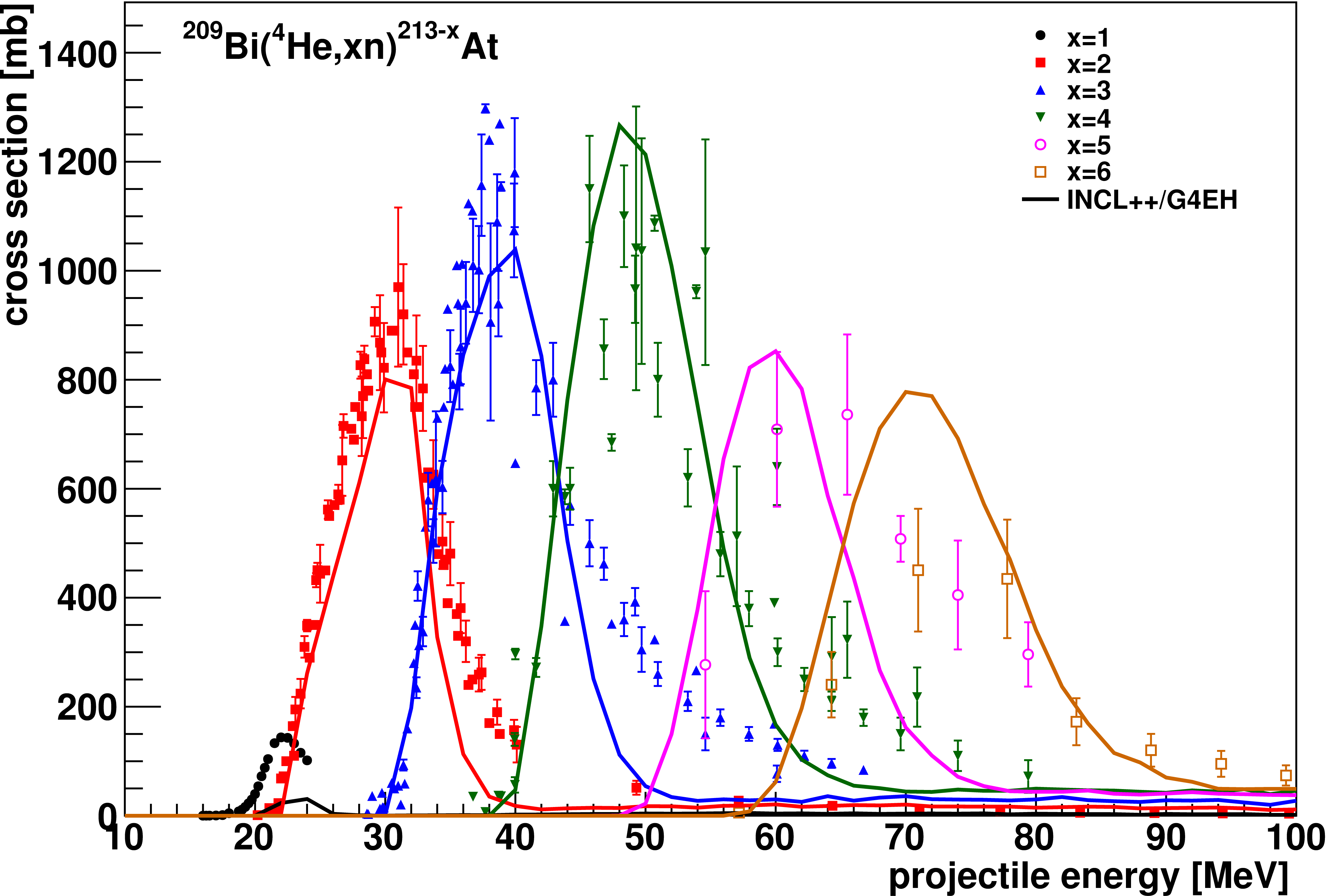Introduction
There is a renewed interest in the study of spallation reactions. This is largely due to new technological applications, such as Accelerator-Driven Systems, consisting of sub-critical nuclear reactor coupled to a particle accelerator. These applications require optimized targets as spallation sources. This type of problem typically involves a large number of parameters and thus it cannot be solved by trial and error. One has to rely on simulations, which implies that very accurate tools need to be developed and their validity and accuracy need to be assessed.
Above \(\sim\)200 MeV incident energy it is necessary to use
reliable models due to the prohibitive number of open channels. The most
appropriate modeling technique in this energy region is intranuclear
cascade (INC) combined with evaporation model. One such pair of models
is the Liège cascade model
INCL++ [BCD+13][MBC+14] coupled with the
G4ExcitationHandler statistical de-excitation model. The strategy
adopted by the INCL++ cascade is to improve the quasi-classical
treatment of physics without relying on too many free parameters.
This chapter introduces the physics provided by INCL++ as
implemented in Geant4. Table 58 summarizes the key
features and provides references to detailed descriptions of the
physics.
The INCL++ model is available through dedicated physics lists (see
Table 58). The _HP variants of the physics lists use
the NeutronHP model (Chapter Low Energy Neutron Interactions) for neutron
interactions at low energy; the QGSP_ and FTFP_ variants
respectively use the QGSP and FTFP model at high energy.
Fig. 110 shows a schematic model map of the
INCL++-based physics lists.
Finally, the INCL++ model is directly accessible through its
interface (G4INCLXXInterface).
The reference paper for the INCL++ model is
Ref. [MBC+14]. Please make sure you cite it
appropriately if you publish any work based on this model.

Fig. 110 Model map for the INCL++-based physics lists. The first two
columns represent nucleon- and pion-induced reactions. The third
column represents nucleus-nucleus reactions where at least one of the
partners is below \(A=18\). The fourth column represents other
nucleus-nucleus reactions.
usage |
|
physics lists |
|
|
|
|
|
|
|
interfaces |
|
|
nucleon-, pion- , kaon- and nucleus-nucleus |
projectile particles |
proton, neutron |
pions (\(\pi^+\), \(\pi^0\), \(\pi^-\)) |
|
kaons (\(K^+\), \(K^-\)) |
|
deuteron, triton |
|
\(^3\)He, \(\alpha\) |
|
light ions (up to \(A=18\)) |
|
energy range |
1 MeV - 20 GeV |
target nuclei |
|
lightest applicable |
deuterium, \(^2\)H |
heaviest |
no limit, tested up to uranium |
features |
no ad-hoc parameters |
realistic nuclear densities |
|
Coulomb barrier |
|
non-uniform time-step |
|
pion and delta production cross sections |
|
delta decay |
|
Pauli blocking |
|
emission of composite particles (\(A\leq8\)) |
|
complete-fusion model at low energy |
|
conservation laws satisfied at the keV level |
|
typical CPU time |
\(0.5\lesssim{}\) |
code size |
75 classes, 14k lines |
references |
Ref. [MBC+14] |
Suitable application fields
The INCL++-dedicated physics lists are suitable for the simulation
of any system where spallation reactions or light-ion-induced reactions
play a dominant role. As examples, we include here a non-exhaustive list
of possible application fields:
Accelerator-Driven Systems (ADS);
spallation targets;
radioprotection close to high-energy accelerators;
radioprotection in space;
proton or carbon therapy;
production of beams of exotic nuclei.
Generalities of the INCL++ cascade
INCL++ is a Monte-Carlo simulation incorporating the aforementioned
cascade physics principles. The INCL++ algorithm consists of an
initialization stage and the actual data processing stage.
The INCL++ cascade can be used to simulate the collisions between
bullet particles and nuclei. The supported bullet particles and the
interface classes supporting them are presented in table Table 58.
The momenta and positions of the nucleons inside the nuclei are determined at the beginning of the simulation run. The proton and neutron density profiles are based on Hartree-Fock-Bogoliubov calculations (Ref. [RodriguezSanchezDM+17]) and the nucleons move in a static potential well. The cascade is modeled by tracking the nucleons and their collisions.
The possible reactions inside the nucleus are
\(NN \rightarrow NN\) (elastic scattering)
\(NN \rightarrow N \Delta\) and \(N \Delta \rightarrow NN\)
\(\Delta \rightarrow \pi N\) and \(\pi N \rightarrow \Delta\)
\(NN \rightarrow NN\,x\pi\) (multiple pion production; \(x \geq 1\))
\(\pi N \rightarrow \pi N\) (elastic scattering and charge exchange)
\(\pi N \rightarrow N\,(x+1)\pi\) (multiple pion production; \(x \geq 1\))
\(NN \rightarrow NN M\,x\pi\) (\(M = \eta\) or \(\omega\); \(x \geq 0\))
\(\pi N \rightarrow M N\) (\(M = \eta\) or \(\omega\))
\(MN \rightarrow \pi N, \pi \pi N\) (\(M = \eta\) or \(\omega\))
\(MN \rightarrow MN\) (\(M = \eta\) or \(\omega\); elastic scattering)
\(NN \rightarrow NYK\,x\pi\) (\(Y = \Lambda\) or \(\Sigma\); \(x \geq 0\))
\(NN \rightarrow NNK\bar{K}\) (\(Y = \Lambda\) or \(\Sigma\))
\(\pi N \rightarrow YK\,x\pi\) (\(Y = \Lambda\) or \(\Sigma\); \(x \geq 0\))
\(\pi N \rightarrow NK\bar{K}\)
\(N\bar{K} \rightarrow N\bar{K}\,x\pi\) (\(x = 0, 1, 2\))
\(N\bar{K} \rightarrow Y\,x\pi\) (\(Y = \Lambda\) or \(\Sigma\); \(x = 1, 2\))
\(NK \rightarrow NK\,x\pi\) (\(x = 0, 1, 2\))
\(NY \rightarrow NY'\) (\(Y,Y' = \Lambda\) or \(\Sigma\))
\(\Delta N \rightarrow NYK\) (\(Y = \Lambda\) or \(\Sigma\))
\(\Delta N \rightarrow \Delta YK\) (\(Y = \Lambda\) or \(\Sigma\))
\(\Delta N \rightarrow NNK\bar{K}\)
Model limits
The INCL++ model has certain limitations with respect to the bullet
particle energy and type, and target-nucleus type. The supported energy
range for incident nucleons and pions is 1 MeV–20 GeV. Any target
nucleus from deuterium (2H) up is in principle acceptable,
but not all areas of the nuclide chart have received equal attention
during testing. Heavy nuclei (say above Fe) close to the stability
valley have been more thoroughly studied than light or unstable nuclei.
The model is anyway expected to accept any existing nucleus as a target.
Light nuclei (from \(A=2\) to \(A=18\) included) can also be
used as projectiles. The G4INCLXXInterface class can be used for
collisions between nuclei of any mass, but it will internally rely on
the Binary Cascade model (see chapter The Binary Cascade Model) if both reaction
partners have \(A>18\). A warning message will be displayed (once)
if this happens.
Physics ingredients
The philosophy of the INCL++ model is to minimize the number of free
parameters, which guarantees the predictive power of the model. All
INCL++parameters are either taken from known phenomenology
(e.g. nuclear radii, elementary cross sections, nucleon potentials) or
fixed once and for all (stopping time, cluster-coalescence parameters).
The nucleons are modeled from HFB calculations (Ref. [RodriguezSanchezDM+17]) in a static potential well. The radius of the well depends on the nucleon momentum, the \(r\)-\(p\) correlation being determined by the desired spatial density distribution \(\rho_r(r)\) according to the following equation:
where \(\rho_p(p)\) is the momentum-space density (drawn from HFB calculations (Ref. [RodriguezSanchezDM+17])).
After the initialization a projectile particle, or bullet, is shot towards the target nucleus. In the following we assume that the projectile is a nucleon, a pion or a kaon; the special case of composite projectiles will be described in more detail in subsection Initialisation of composite projectiles.
The impact parameter, i.e. the distance between the projectile particle and the center point of the projected nucleus surface is chosen at random. The value of the impact parameter determines the point where the bullet particle will enter the calculation volume. After this the algorithm tracks the nucleons by determining the times at which an event will happen. The possible events are:
collision
decay of a delta resonance
reflection from the nuclear potential well
transmission through the nuclear potential well
The particles are assumed to propagate along straight-line trajectories. The algorithm calculates the time at which events will happen and propagates the particles directly to their positions at that particular point in time. This means that the length of the time step in simulation is not constant, and that we do not need to perform expensive numerical integration of the particle trajectories.
Particles in the model are labeled either as participants (projectile particles and particles that have undergone a collision with a projectile) or spectators (target particles that have not undergone any collision). Collisions between spectator particles are neglected.
Emission of composite particles
INCL++ is able to simulate the emission of composite particles (up
to \(A=8\)) during the cascade stage. Clusters are formed by
coalescence of nucleons; when a nucleon (the leading particle) reaches
the surface and is about to leave the system, the coalescence algorithm
looks for other nucleons that are “sufficiently close” in phase space;
if any are found, a candidate cluster is formed. If several clusters are
formed, the algorithm selects the least excited one. Penetration of the
Coulomb barrier is tested for the candidate cluster, which is emitted if
the test is successful; otherwise, normal transmission of the leading
nucleon is attempted.
There are at least two peculiarities of INCL++‘s
cluster-coalescence algorithm. First, it acts in phase space, while
many existing algorithms act in momentum space only. Second, it is
dynamical, in the sense that it acts on the instantaneous phase-space
distribution of nucleons in the system, and not on the distribution of
the escaping nucleons.
Cascade stopping time
Stopping time is defined as the point in time when the cascade phase is
finished and the excited remnant is passed to evaporation model. In the
INCL++ model the stopping time, \(t_\text{stop}\), is defined
as:
Here \(A_\text{target}\) is the target mass number and \(t_0=70\) fm/\(c\). The intranuclear cascade also stops if no participants are left in the nucleus.
Conservation laws
The INCL++ model generally guarantees energy and momentum
conservation at the keV level, which is compatible with the numerical
accuracy of the code. It uses G4ParticleTable and G4IonTable for
the masses of particles and ions, which means that the energy balance is
guaranteed to be consistent with radiation transport. However,
INCL++ can occasionally generate an event such that conservation
laws cannot be exactly fulfilled; these corner cases typically happen
for very light targets.
Baryon number and charge are always conserved.
Initialisation of composite projectiles
In the case of composite projectiles, the projectile nucleons are initialised off their mass shell, to account for their binding in the projectile. The sum of the four-momenta of the projectile nucleons is equal to the nominal four-momentum of the projectile nucleus.
Given a random impact parameter, projectile nucleons are separated in
geometrical spectators (those that do not enter the calculation volume)
and geometrical participants (those that do). Geometrical participant
that traverse the nucleus without undergoing any collision are coalesced
with any existing geometrical spectators to form an excited
projectile-like pre-fragment. The excitation energy of the pre-fragment
is generated by a simple particle-hole model. At the end of the cascade
stage, the projectile-like pre-fragment is handed over to
G4ExcitationHandler.
Two meson resonances implemented: \(\eta\) and \(\omega\)
The mesons \(\eta\) and \(\omega\) can be produced and emitted during the intranuclear cascade phase. The cross sections taken into account are listed in section Generalities of the INCL++ cascade. By default in Geant4 the \(\eta\) meson emitted is not decayed by INCL++, while that is the case for the \(\omega\) meson (then only the decay products (\(\pi\) and \(\gamma\)) are given to Geant4). More details will be available in a paper published soon.
Strangeness added: Kaon, \(\Lambda\) and \(\Sigma\)
Strangeness degree of freedom is available in INCL++ with production, scattering
and absorption of eight new particles (the four kaons, the \(\Lambda\) and
the three \(\Sigma\)). The cross sections taken into account are listed in
section Generalities of the INCL++ cascade. In this first version hyperons are forced to decay at the
end of the cascade. More details will be available in a paper published soon.
De-excitation phase
The INCL++ model simulates only the first part of the nuclear
reaction; the de-excitation of the cascade remnant is simulated by
default by G4ExcitationHandler. As an alternative, the
ABLA++ model (Chapter ABLA++ evaporation/fission model) can be used instead, by
employing the technique described in the Application Developer Guide,
section “hadronic interactions”.
Physics performance

Fig. 111 Left: double-differential cross sections for the production of charged pions in 730-MeV \(p\)+Cu.
Right: double-differential cross sections for the production of neutrons in 290-\(A\)MeV
\(^{12}\)C+\(^{12}\)C. Predictions of the INCL++ and Binary-Cascade models are compared with experimental data from Refs. [CDG+72] and [IMS+01].

Fig. 112 Excitation functions for \((\alpha,xn)\) cross sections on
\(^{209}\)Bi. The predictions of
INCL++-G4ExcitationHandler are represented by the solid line
and are compared to experimental data
[eal05][BL74][KSegre49][DL74][PatelShahSingh99][RBAC90][SH74][SMS94][LM85].
INCL++ (coupled with G4ExcitationHandler) provides an accurate
modeling tool for spallation studies in the tens of MeV–15 GeV energy
range. The INCL++-ABLA07 [KAH08] model was
recognized as one of the best on the market by the IAEA Benchmark of
Spallation Models [IAE] (note that
the ABLA07 de-excitation model is presently available in Geant4 as ABLA++).
As a sample of the quality of the model predictions of
INCL++-G4ExcitationHandler for nucleon-induced reactions, the
left panel of Fig. 111 presents a comparison of
double-differential cross sections for pion production in 730-MeV
\(p\)+Cu, compared with the predictions of the Binary-Cascade
model (chapter The Binary Cascade Model) and with experimental data.
Reactions induced by light-ion projectiles up to \(A=18\) are also
treated by the model. The right panel of
Fig. 111 shows double-differential cross
sections for neutron production in 290-\(A\)MeV
\(^{12}\)C+\(^{12}\)C. Fig. 112
shows excitation curves for \(^{209}\)Bi\((\alpha,xn)\)
reactions at very low energy. We stress here that intranuclear-cascade
models are supposedly not valid below \(\sim150\) \(A\)MeV.
The very good agreement presented in Fig. 112
is due to the complete-fusion model that smoothly replaces INCL++ at
low energy.
INCL++ is continuously updated and validated against experimental
data.
Bibliography
- BL74
A. R. Barnett and J. S. Lilley. Interaction of alpha particles in the lead region near the coulomb barrier. Physical Review C, 9(5):2010–2027, may 1974. URL: https://doi.org/10.1103/PhysRevC.9.2010, doi:10.1103/physrevc.9.2010.
- BCD+13
A. Boudard, J. Cugnon, J.-C. David, S. Leray, and D. Mancusi. New potentialities of the liège intranuclear cascade model for reactions induced by nucleons and light charged particles. Physical Review C, jan 2013. URL: https://doi.org/10.1103/PhysRevC.87.014606, doi:10.1103/physrevc.87.014606.
- CDG+72
D. R. F. Cochran, P. N. Dean, P. A. M. Gram, E. A. Knapp, E. R. Martin, D. E. Nagle, R. B. Perkins, W. J. Shlaer, H. A. Thiessen, and E. D. Theriot. Production of charged pions by 730-MeV protons from hydrogen and selected nuclei. Physical Review D, 6(11):3085–3116, dec 1972. URL: https://doi.org/10.1103/PhysRevD.6.3085, doi:10.1103/physrevd.6.3085.
- DL74
G Deconninck and M Longree. Fonctions d’excitation des réactions induites par particules alpha sur 209 bi entre 40 et 100 mev. In Annales de la Societé Scientifique de Bruxelles, volume 88, 341–346. 1974.
- eal05
A. Hermanne et al. Experimental study of the cross sections of $\alpha -$particle induced reactions on $^209$bi. In AIP Conference Proceedings. AIP, 2005. Conf. on Nucl. Data for Sci. and Techn., Santa Fe 2004. URL: https://doi.org/10.1063/1.1945163, doi:10.1063/1.1945163.
- IAE
IAEA. Benchmark of spallation models, organized by the iaea. http://www-nds.iaea.org/spallations. [Online; accessed 28-october-2017].
- IMS+01
Y. Iwata, T. Murakami, H. Sato, H. Iwase, T. Nakamura, T. Kurosawa, L. Heilbronn, R. M. Ronningen, K. Ieki, Y. Tozawa, and K. Niita. Double-differential cross sections for the neutron production from heavy-ion reactions at energiesE/a=290–600mev. Physical Review C, oct 2001. URL: https://doi.org/10.1103/PhysRevC.64.054609, doi:10.1103/physrevc.64.054609.
- KAH08
Ricciardi M V Kelic A and Schmidt K H. Abla07 — towards a complete description of the decay channels of a nuclear system from spontaneous fission to multifragmentation. In D Filges, S Leray, Y Yariv, A Mengoni, A Stanculescu, and G Mank Eds., editors, Proceedings of the Joint ICTP-IAEA Advanced Workshop on Model Codes for Spallation Reactions, number INDC(NDS)-530, 181. ICTP Trieste, Italy, 4-8 February 2008. IAEA, IAEA Vienna, August 2008. download: https://www-nds.iaea.org/publications/indc/indc-nds-0530.pdf.
- KSegre49
E. L. Kelly and E. Segrè. Some excitation functions of bismuth. Physical Review, 75(7):999–1005, apr 1949. URL: https://doi.org/10.1103/PhysRev.75.999, doi:10.1103/physrev.75.999.
- LM85
Richard M. Lambrecht and Saed Mirzadeh. Cyclotron isotopes and radiopharmaceuticals—XXXV astatine-211. The International Journal of Applied Radiation and Isotopes, 36(6):443–450, jun 1985. URL: https://doi.org/10.1016/0020-708X(85)90207-8, doi:10.1016/0020-708x(85)90207-8.
- MBC+14(1,2,3,4)
Davide Mancusi, Alain Boudard, Joseph Cugnon, Jean-Christophe David, Pekka Kaitaniemi, and Sylvie Leray. Extension of the liège intranuclear-cascade model to reactions induced by light nuclei. Physical Review C, nov 2014. URL: https://doi.org/10.1103/PhysRevC.90.054602, doi:10.1103/physrevc.90.054602.
- RBAC90
I.A. Rizvi, M.K. Bhardwaj, M.Afzal Ansari, and A.K. Chaubey. Non-equilibrium reaction mechanism in alpha-particle induced excitation function for 209bi up to 60 MeV. International Journal of Radiation Applications and Instrumentation. Part A. Applied Radiation and Isotopes, 41(2):215–219, jan 1990. URL: https://doi.org/10.1016/0883-2889(90)90112-T, doi:10.1016/0883-2889(90)90112-t.
- RodriguezSanchezDM+17(1,2,3)
Jose Luis Rodríguez-Sánchez, Jean-Christophe David, Davide Mancusi, Alain Boudard, Joseph Cugnon, and Sylvie Leray. Improvement of one-nucleon removal and total reaction cross sections in the liège intranuclear-cascade model using hartree-fock-bogoliubov calculations. Phys. Rev. C, 96:054602, Nov 2017. URL: https://link.aps.org/doi/10.1103/PhysRevC.96.054602, doi:10.1103/PhysRevC.96.054602.
- SMS94
N. L. Singh, S. Mukherjee, and D. R. S. Somayajulu. Non-equilibrium analysis of ($\alpha ,x n$) reactions on heavy nuclei. Il Nuovo Cimento A, 107(9):1635–1645, sep 1994. URL: https://doi.org/10.1007/BF02780697, doi:10.1007/bf02780697.
- SH74
J. D. Stickler and K. J. Hofstetter. Comparison of ³he-, $^4$he-, and $^12$c-induced nuclear reactions in heavy-mass targets at medium excitation energies. i. experimental cross sections. Physical Review C, 9(3):1064–1071, mar 1974. URL: https://doi.org/10.1103/PhysRevC.9.1064, doi:10.1103/physrevc.9.1064.
- PatelShahSingh99
H. B. Patel, D. J. Shah, and N. L. Singh. Study of ($\alpha ,xn$) reactions on $^169$Tm, $^181$Ta and $^209$Bi up to 70 MeV. Nuovo Cimento A Serie, 112:1439, December 1999.